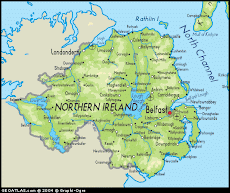I’ve had a lot of people ask me about my experience here on the infamous ‘Twelfth of July’ so I figured I should go ahead and write about it. Please know that this is just my experience and if I hadn’t had Chris and Jonny to show me around the city, I never would have gotten the experience I did. As it is, I’m very glad I got to see and hear all the sights and sounds of the Twelfth, and it’s certainly something I’ll not soon forget.
The Twelfth celebrations are to commemorate the victory of King William of Orange (the Protestant Dutch king and son-in-law to James II of England) over King James II (the Catholic king of the English, Scottish and Irish thrones and father-in-law to William.) William deposed James in 1688. James, who wanted the throne back, launched a campaign against William which lasted several years. Eventually, the two forces met just outside Drogheda, Ireland, on opposite banks of the River Boyne on July 1, 1690. (When the calendar changed from the ‘old style’ Julian to the ‘new style’ Gregorian, the date moved to the 12th.) William’s victory was a decisive turning point in James’ overall unsuccessful attempt to regain the British crown, and helped to seal Protestant supremacy in Ireland. His success is still celebrated by the Orange Order and is commemorated by the Protestant side of the community with parades, bands and bonfires. (If you’d like some more information about the Battle, go here. If you want WAY more information about the Battle, click here. If this is all the information you want, keep reading.)
One of the nearby estates, Tiger’s Bay, happens to be home to several youth who I work with in the church. Every year, just like so many other Loyalist estates, they have a huge bonfire to commemorate the Twelfth. I was invited down, and thought it would certainly be educational and possibly even fun. I did have my reservations, however, since I had heard enough about ‘bonfire season’ to know that I didn’t really agree with the politics of it all, but I figured I couldn’t make an educated analysis until I experienced it. So after watching Holland lose in the World Cup final, I went down to Tiger’s Bay. Chris was there, also, which was surprising since he’ll readily tell you how much he loathes the Twelfth, but it ended up being a very good thing. As I said before, if he hadn’t been there, I doubt I would’ve ended up with the night I had.
The bonfires are lit at midnight, so partying starts late on the night of the 11th. Amateur bands (think fife and drum corps) parade through the estate with dozens, of people following. Fireworks are set off, but since they aren’t professionally done some end up in the crowd instead of in the air. Several shot off into the throngs of people and one even exploded beside a child’s pram. I was relieved to see that even amongst the seeming chaos this action was not tolerated. The fireworks display-men were severely rebuked by the child’s father. Once all the fireworks are shot and enough alcohol has consumed to sterilize an operating room, the bonfire is lit.
You must understand that bonfires here are like nothing I’ve ever seen in the States. My ‘Uncle’ Jim, who has several acres of land out in the country, often hosts bonfires in the summer and fall for various events. Three what-I-always-thought-were-huge piles of brush and random land debris sit at strategic points around the property waiting to be lit. The fire department is always warned (it’s a small town,) and precautions—even if small—are taken. Compared to bonfires here, Jim’s are mere campfires suitable for Girl Scouts to roast marshmallows and sing Kum Ba Yah while retelling ghost stories they read in Highlights magazine. Bonfires in Northern Ireland are not measured in feet or meters but in stories. In fact, many that I saw were actually bigger than the houses they stood near. Whole trees could be consumed and you might never know. Beowulf’s funeral pyre was smaller than some of these infernos. Just imagine a house on fire and you’ve pretty much got it.
Back to midnight. The bonfire is lit. Gasoline is the preferred accelerant and dozens of gallons are dumped over the wood. In no time the whole pile is alight. I watched in horrid fascination as thousands of pounds of wood, tires and other debris went up in flames, and stood dumb-struck as the moment everyone was waiting for occurred. At the top of each bonfire flies a large Irish Tri-Color, symbol of the Republic, Catholics and all things hated by Loyalists. As the fire leaps up, the nylon flag begins to melt and is soon completely consumed. When the flag burns, the people cheer. I cried. I didn’t understand. Still don’t.
At about 12.30 Chris and I decided that it would be interesting to drive up to ‘the horseshoe,’ an overlook point north of the city, to see how many bonfires we could see. We weren’t the only ones with this idea and dozens of people crowded the small space on the side of the road to watch the city burn. Plumes of thick, black, oily smoke rose from countless estates. The environmentalist in me wept more than the reconciliation volunteer. When I told my mother about it, she described it as, ‘Northern Ireland’s version of a BP oil spill.’
After a half hour or so watching the bonfires rage, Chris and I went driving around the city scouting bonfires. We saw several where they were supposed to be and some where they weren’t supposed to be. At one area in mixed West Belfast, at an interface or ‘flashpoint,’ the burning wreckage of a car sat at an intersection surrounded by police. At nearly 3.00am we decided to head home, making one more stop in Tiger’s Bay to check on the kids we often work with.
Loyalist Tiger’s Bay sits right beside Nationalist New Lodge and Chris and I happened to be driving up the road that acts as a buffer between these two communities. A line of heavily armored police vehicles sat just a few dozen yards down the cross street inside New Lodge. We parked and got out, hoping not to see any of our kids up the side street in Tiger’s Bay. By and large, Protestant communities don’t start riots, but they are definitely drawn to them and will readily take part. Dozens of Nationalist protesters stood in front of the police yelling insults and threats. Several youths from Tiger’s Bay came down the street from the other direction wondering at the noise. We recognized several, and told them to just go home. Surprisingly, they did. Suddenly, at some pre-arranged time, a signal was given among the rioters and they began throwing bottles at the police line. Glass rained down on the riot-gear-clad officers and the armored cars for several minutes. It seemed as though every recycling bin in the estate had been dragged out into the street and was being emptied over the heads of Belfast’s finest. Once all the bottles had been used up, the rioters quickly retreated back into the flat towers and houses, ‘to re-group’ as Chris said.
I was in shock. Having grown up in a small fairly WASP town in the South and generally not having reasons to find myself at flashpoint zones at 3.00am, I had never seen anything like this. The closest thing I had ever seen to a riot was watching from my apartment’s front porch as the Boone police broke up first week parties at the houses across the street when I was in college. That’s child’s play compared to this.
At about 3.30am, things were fairly settled. The rioters were nowhere to be seen, our kids had all gone home, and all was quiet. Too quiet. Chris is no stranger to Twelfth night riots and he felt none too good about staying any longer, so we left. Good thing, too, since the next morning we found out that the police in the area had actually come under live fire, with 3 officers shot (none fatally,) one of whom we had been talking to. It was all very surreal. (Still is.)
The morning of the Twelfth, Jonny offered to take me into City Centre to watch the parades. Thousands of people gather for parades all over Northern Ireland, with Belfast being the main flagship parade for the country. Nearly every Orange Hall has several divisions attached to it and almost each division has its own band. These bands all parade from their home estates into City Centre where they all join together to form one massive parade that winds its way through town out to a park where there are speeches, more music, food and games. Thousands line the streets to watch these bands and the Orangemen march. Only one thing you need to know about Orange bands: if you have seen one, you have seen them all. I mean that with no disrespect to the many people I know who support various Orange bands, but musically they’re pretty much all the same with few exceptions. Flutes, snares and a bass drum all played decently enough, but several hundred good-yet-amateur bands over the course of a few hours after a night of dodging flying lager bottles starts to eventually sound less and less like music and more and more like a playground full of 4-year-olds with whistles and pot lids. Also, regardless of what you’re playing, there’s just no need to hit a bass drum that hard. Yes, it’s meant to be whacked about, and no, I’m not a drummer, but I should think that if the heads are dented then you’re probably playing it too hard. But enough of my musical pretention. The parades themselves are fun enough, if you like that sort of thing and you don’t mind being inundated and drenched with Union Jacks, Red Hands of Ulster, Orange banners, and all things Loyalist. Lots of families, friends, flags, flutes, food, and the odd vuvuzela make for an interesting time.
Overall, the Twelfth is truly something that must be experienced to even try to be understood, and even that’s a stretch. I don’t understand it at all, and neither do many people who grew up here and live here. I’ve yet to really debrief my experience—if I ever will—but it’s definitely something I won’t soon forget. And you can bet that every Twelfth of July from now until the Rapture will be spent in prayer.
(For pictures of all this, go to 'The Twelfth' under the Picture Gallery)


No comments:
Post a Comment